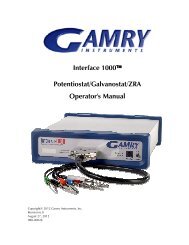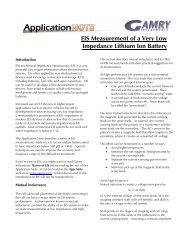Basics of Electrochemical Impedance Spectroscopy - Gamry ...
Basics of Electrochemical Impedance Spectroscopy - Gamry ...
Basics of Electrochemical Impedance Spectroscopy - Gamry ...
Create successful ePaper yourself
Turn your PDF publications into a flip-book with our unique Google optimized e-Paper software.
The general relation between the potential and the<br />
current (which is directly related with the amount <strong>of</strong><br />
electrons and so the charge transfer via Faradays law) is:<br />
i i CO<br />
αnFη CR<br />
−( 1−<br />
α) nFη<br />
= 0(<br />
exp( ) − ( exp(<br />
) )<br />
* O * R<br />
C RT C RT<br />
with,<br />
i 0<br />
C O<br />
= exchange current density<br />
= concentration <strong>of</strong> oxidant at the electrode<br />
surface<br />
C O * = concentration <strong>of</strong> oxidant in the bulk<br />
C R<br />
= concentration <strong>of</strong> reductant at the electrode<br />
surface<br />
η = overpotential (E app – E oc)<br />
F = Faradays constant<br />
T = temperature<br />
R = gas constant<br />
α = reaction order<br />
n = number <strong>of</strong> electrons involved<br />
(17)<br />
When the concentration in the bulk is the same as at the<br />
electrode surface, C O =C O * and C R =C R *. This<br />
simplifies equation 17 into:<br />
nF<br />
nF<br />
i = i 0 (exp( α η) - exp(-(1- α) η)<br />
RT<br />
RT (18)<br />
This equation is called the Butler-Volmer equation. It is<br />
applicable when the polarization depends only on the<br />
charge-transfer kinetics. Stirring the solution to minimize<br />
the diffusion layer thickness can help minimize<br />
concentration polarization.<br />
When the overpotential, η, is very small and the<br />
electrochemical system is at equilibrium, the expression<br />
for the charge transfer resistance changes to:<br />
RT<br />
Rct<br />
=<br />
nFi<br />
0<br />
(19)<br />
From this equation the exchange current density can be<br />
calculated when R ct is known.<br />
8<br />
Diffusion<br />
Diffusion also can create an impedance called a<br />
Warburg impedance. The impedance depends on the<br />
frequency <strong>of</strong> the potential perturbation. At high<br />
frequencies, the Warburg impedance is small since<br />
diffusing reactants don't have to move very far. At low<br />
frequencies, the reactants have to diffuse farther,<br />
increasing the Warburg-impedance.<br />
The equation for the "infinite" Warburg impedance is:<br />
-½<br />
Z = σ ( ω ) (1- j) (20)<br />
W<br />
On a Nyquist Plot the Warburg impedance appears as a<br />
diagonal line with an slope <strong>of</strong> 45°. On a Bode Plot, the<br />
Warburg impedance exhibits a phase shift <strong>of</strong> 45°.<br />
In equation 20, σ is the Warburg coefficient defined as:<br />
σ =<br />
In which,<br />
RT 1 1<br />
( + )<br />
2 2<br />
* O * R<br />
n F A√ 2 C √ D C √ D<br />
ω = radial frequency<br />
D O<br />
D R<br />
O R<br />
= diffusion coefficient <strong>of</strong> the oxidant<br />
= diffusion coefficient <strong>of</strong> the reductant<br />
A = surface area <strong>of</strong> the electrode<br />
n = number <strong>of</strong> electrons involved<br />
(21)<br />
This form <strong>of</strong> the Warburg impedance is only valid if the<br />
diffusion layer has an infinite thickness. Quite <strong>of</strong>ten,<br />
however, this is not the case. If the diffusion layer is<br />
bounded, the impedance at lower frequencies no longer<br />
obeys the equation above. Instead, we get the form:<br />
with,<br />
-½<br />
Z O = σ ω (1- j) δ ω j ½<br />
tanh( ( ) )<br />
D<br />
δ = Nernst diffusion layer thickness<br />
D = some average value <strong>of</strong> the diffusion<br />
coefficients <strong>of</strong> the diffusing species<br />
This more general equation is called the "finite"<br />
Warburg. For high frequencies where ω→∞, or for an<br />
infinite thickness <strong>of</strong> the diffusion layer where δ→∞,<br />
(22)




